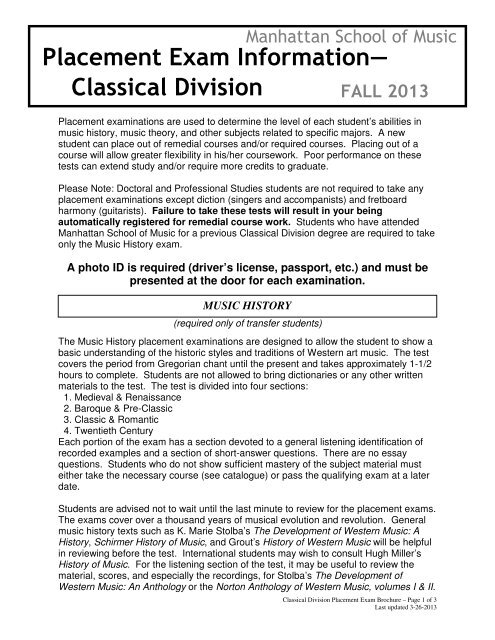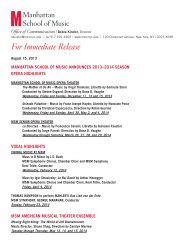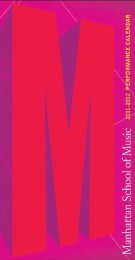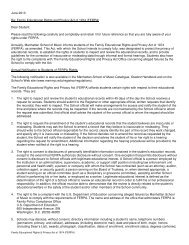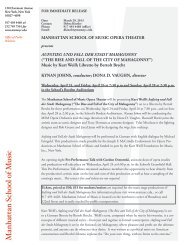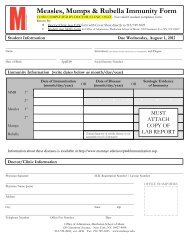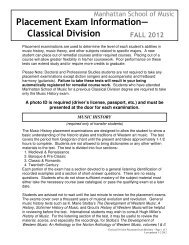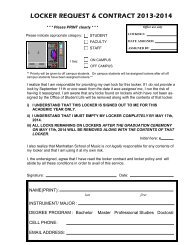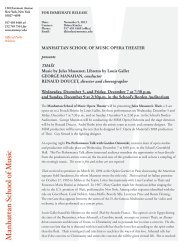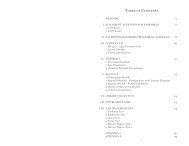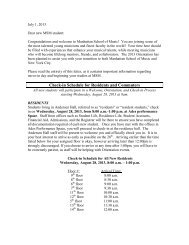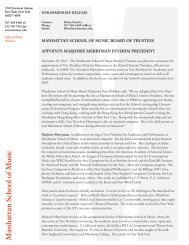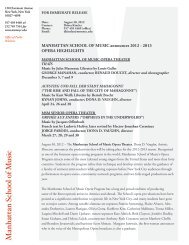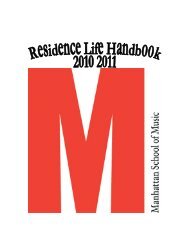Placement Exam Information - Manhattan School of Music
Placement Exam Information - Manhattan School of Music
Placement Exam Information - Manhattan School of Music
You also want an ePaper? Increase the reach of your titles
YUMPU automatically turns print PDFs into web optimized ePapers that Google loves.
<strong>Manhattan</strong> <strong>School</strong> <strong>of</strong> <strong>Music</strong><br />
<strong>Placement</strong> <strong>Exam</strong> <strong>Information</strong>—<br />
Classical Division<br />
<strong>Placement</strong> examinations are used to determine the level <strong>of</strong> each student’s abilities in<br />
music history, music theory, and other subjects related to specific majors. A new<br />
student can place out <strong>of</strong> remedial courses and/or required courses. Placing out <strong>of</strong> a<br />
course will allow greater flexibility in his/her coursework. Poor performance on these<br />
tests can extend study and/or require more credits to graduate.<br />
Please Note: Doctoral and Pr<strong>of</strong>essional Studies students are not required to take any<br />
placement examinations except diction (singers and accompanists) and fretboard<br />
harmony (guitarists). Failure to take these tests will result in your being<br />
automatically registered for remedial course work. Students who have attended<br />
<strong>Manhattan</strong> <strong>School</strong> <strong>of</strong> <strong>Music</strong> for a previous Classical Division degree are required to take<br />
only the <strong>Music</strong> History exam.<br />
A photo ID is required (driver’s license, passport, etc.) and must be<br />
presented at the door for each examination.<br />
MUSIC HISTORY<br />
(required only <strong>of</strong> transfer students)<br />
FALL 2013<br />
The <strong>Music</strong> History placement examinations are designed to allow the student to show a<br />
basic understanding <strong>of</strong> the historic styles and traditions <strong>of</strong> Western art music. The test<br />
covers the period from Gregorian chant until the present and takes approximately 1-1/2<br />
hours to complete. Students are not allowed to bring dictionaries or any other written<br />
materials to the test. The test is divided into four sections:<br />
1. Medieval & Renaissance<br />
2. Baroque & Pre-Classic<br />
3. Classic & Romantic<br />
4. Twentieth Century<br />
Each portion <strong>of</strong> the exam has a section devoted to a general listening identification <strong>of</strong><br />
recorded examples and a section <strong>of</strong> short-answer questions. There are no essay<br />
questions. Students who do not show sufficient mastery <strong>of</strong> the subject material must<br />
either take the necessary course (see catalogue) or pass the qualifying exam at a later<br />
date.<br />
Students are advised not to wait until the last minute to review for the placement exams.<br />
The exams cover over a thousand years <strong>of</strong> musical evolution and revolution. General<br />
music history texts such as K. Marie Stolba’s The Development <strong>of</strong> Western <strong>Music</strong>: A<br />
History, Schirmer History <strong>of</strong> <strong>Music</strong>, and Grout’s History <strong>of</strong> Western <strong>Music</strong> will be helpful<br />
in reviewing before the test. International students may wish to consult Hugh Miller’s<br />
History <strong>of</strong> <strong>Music</strong>. For the listening section <strong>of</strong> the test, it may be useful to review the<br />
material, scores, and especially the recordings, for Stolba’s The Development <strong>of</strong><br />
Western <strong>Music</strong>: An Anthology or the Norton Anthology <strong>of</strong> Western <strong>Music</strong>, volumes I & II.<br />
Classical Division <strong>Placement</strong> <strong>Exam</strong> Brochure – Page 1 <strong>of</strong> 3<br />
Last updated 3-26-2013
REQUIRED PIANO<br />
(required <strong>of</strong> all students except keyboard and guitar majors)<br />
The required piano exam includes reading at sight and the demonstration <strong>of</strong> the<br />
following skills: major and minor scales, chord progressions, triads and inversions,<br />
harmonization, transposition, and sight-reading. The level <strong>of</strong> sight-reading is equivalent<br />
to repertoire from the text Essential Keyboard Repertoire Vol. I, ed. Lynn Olson. If you<br />
have never had piano training, you will be placed immediately into Required Piano I.<br />
More information is available upon request.<br />
THEORETICAL STUDIES<br />
(required <strong>of</strong> all students)<br />
Students must acquire a musical education that goes beyond the technical training<br />
needed for performance. Those enrolled in a degree or diploma program at <strong>Manhattan</strong><br />
<strong>School</strong> <strong>of</strong> <strong>Music</strong> are required to gain fluency in analytical skills and understanding <strong>of</strong> the<br />
structural forces that underlie musical composition.<br />
The theory curriculum at MSM stresses the interdependence <strong>of</strong> theoretical skills and<br />
performance. Based on this premise, placement examinations determine that student’s<br />
levels <strong>of</strong> skill in harmony, counterpoint, form and analysis, dictation, and sight-singing.<br />
These examinations are to be taken only once.<br />
Undergraduate students who do not meet college-level standards at <strong>Manhattan</strong> <strong>School</strong><br />
<strong>of</strong> <strong>Music</strong> are placed in remedial classes. For graduate students whose placement<br />
exams indicate some deficiencies but a reasonable knowledge <strong>of</strong> undergraduate theory,<br />
the department <strong>of</strong>fers various courses, which complete the theory requirements at<br />
MSM. These courses do not count toward the cumulative credit needed to graduate<br />
with the master’s degree. The tests include:<br />
Harmony/Counterpoint/Form and Analysis:<br />
Testing commences with rudiments – clefs, key signatures, intervals, accidentals, and<br />
rhythm. Sufficient knowledge allows the applicant to continue with the materials <strong>of</strong><br />
diatonic harmony, chromatic harmony, modulations, figured bass, melody<br />
harmonization, and analysis <strong>of</strong> harmony, counterpoint, and form. Those who have<br />
indicated a working knowledge <strong>of</strong> this area proceed to principles <strong>of</strong> the 20 th century.<br />
Dictation:<br />
The instructor plays on the piano the musical material, which the students are expected<br />
to notate. Melodic, harmonic, and rhythmic material will be played, beginning with<br />
simple diatonic material and progressing to more difficult chromatic and atonal material.<br />
To permit the student to complete each example, several repetitions will be played.<br />
Sight-Singing:<br />
Students will be expected to sing melodies and perform rhythms at sight. This course <strong>of</strong><br />
study parallels the contents <strong>of</strong> the harmony/counterpoint curriculum. <strong>Manhattan</strong> <strong>School</strong><br />
<strong>of</strong> <strong>Music</strong> uses the “fixed do” and “movable numbers” methods.<br />
Fretboard harmony (guitar majors only):<br />
This test is designed to determine the level <strong>of</strong> knowledge <strong>of</strong> the fretboard fingerings,<br />
harmony, sight-reading, transposition, and figured bass.<br />
Classical Division <strong>Placement</strong> <strong>Exam</strong> Brochure – Page 2 <strong>of</strong> 3<br />
Last updated 3-26-2013
KEYBOARD SKILLS<br />
(required <strong>of</strong> all keyboard students)<br />
The keyboard skills exam includes sight-reading at the keyboard (see below) as<br />
well as demonstration <strong>of</strong> the following skills (undergraduate and graduate piano<br />
majors):<br />
major and minor scales, chord progressions, realization <strong>of</strong> a figured bass, sight-reading<br />
a string quartet excerpt from the classical period, sight-reading an orchestral score from<br />
the classical period, and transposition <strong>of</strong> a song the distance <strong>of</strong> a whole step from the<br />
original key. Departmental texts include Figured Harmony at the Keyboard Part 1 by<br />
R.O. Morris, Oxford University Press, and Preparatory Exercises in Score Reading by<br />
R.O. Morris and Howard Ferguson, Oxford University Press.<br />
Sight-Reading at the Keyboard (undergraduate piano only):<br />
This test examines the student’s ability to play piano literature at sight. Elements <strong>of</strong><br />
tempo, accuracy, and interpretation will be taken into consideration. The level <strong>of</strong> reading<br />
is equivalent to easier sonatas by Haydn, waltzes and mazurkas by Chopin, and pieces<br />
from the Bartók Mikrokosmos through Volume 4.<br />
Classical Division <strong>Placement</strong> <strong>Exam</strong> Brochure – Page 3 <strong>of</strong> 3<br />
Last updated 3-26-2013


